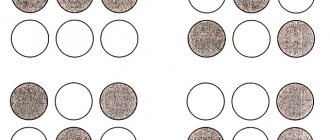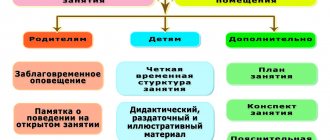Structure
The internal structure of fish is presented in the table.
| Organ system | Organs | general characteristics |
| Musculoskeletal | Skeleton, muscles | The skull includes the braincase, paired gill covers and arches, and jaws. The paired fins are mobile. The spine consists of vertebrae with processes - two look down and form ribs, one is raised up. The muscles are divided into segments. |
| Digestive | Digestive tract, glands | The tract consists of the mouth, pharynx, esophagus, stomach, and intestines. Ends with the anus. The ducts of the pancreas and liver open into the intestines. Some fish have teeth. |
| excretory | Ribbon-shaped paired kidneys, ureters, bladder | The blood is filtered by the kidneys. Urine is formed and flows through the ureters into the bladder. From there it is excreted through the urethra. |
| Respiratory | Gills | Located in the pharynx. Gill filaments, which are penetrated by capillaries, are attached to the gill arches. Gas exchange occurs through them. |
| Blood | Two-chambered heart, arteries, veins, capillaries | The heart consists of a ventricle and an atrium, through which venous blood passes. One circle of blood circulation starting from the ventricle. Venous blood flows through the gills, becoming saturated with oxygen. After oxygen is delivered to all organs and tissues, the blood returns to the atrium. |
| Nervous | The brain includes the forebrain, diencephalon, medulla oblongata, midbrain and cerebellum. The spinal cord, which is located in the spinal canal, and nerves begin from the brain. | The midbrain, diencephalon and cerebellum are well developed. The sense organs are represented by the eyes, nostrils, inner ear, and lateral line, which detects vibrations. Taste buds are located in the mouth and on the skin. |
| Sexual | Ovaries and oviducts in females and testes and vas deferens in males | Fertilization is most often external |
Rice.
2. Internal structure. The scales of fish are constantly growing, and annual rings are formed on them.
Preview:
SUMMARY OF NOD "OUR AQUARIUM"
(integration of areas of artistic creativity, reading fiction)
Compiled by Yulia Aleksandrovna Rizvanova, teacher of the MBDOU “Kindergarten of compensatory type No. 67 “Nadezhda”, Naberezhnye Chelny
Educational areas: artistic creativity, reading fiction, communication, music, cognition (FCCM)
Goals: - improve drawing skills with wax pencils and watercolors, developing fine motor skills;
- learn to fill out the entire sheet, convey characteristic details, supplement the drawing with details (algae, pebbles), developing creative imagination;
— cultivate the ability to finish what you start, and not disturb the person sitting next to you.
Materials: for children: wax crayons of different colors, brushes, jars of water, watercolor paints, white album sheets, stands for brushes, napkins;
demonstration: images of aquarium fish, illustrations of an aquarium; a sketch prepared by the teacher to demonstrate the technique of drawing a fish, a jar with a fish.
Preliminary work: - examining the aquarium;
— a conversation about aquarium fish, how to care for them;
— drawing classes: with watercolors “Goldfish”, watercolors and wax pencils “Summer Meadow”.
Speech development: developing the skill of agreeing adjectives with nouns in gender, number, case; fix the names of aquarium fish.
Communicative game “Hello” words and music by M. Kartushina. Hello, palms! - Extend your arms and turn your palms up. Clap-clap-clap! - 3 claps.
Description
Fish are symmetrical animals with a streamlined body shape. Bottom-dwelling, camouflaged fish that lead a sedentary lifestyle have a non-streamlined body shape.
Fish are perfectly adapted to life in water, as evidenced by the features of their external structure:
- thin skin with mucous glands is covered with scales;
- fins (caudal, dorsal, pectoral, ventral, anal), located throughout the body, help to swim;
- the head is not separated from the body, and the body is not separated from the tail;
- there are well developed gills.
Rice.
1. External structure. The development of fish classes dates back to the Devonian period (approximately 300 million years ago). All fish descended from a common ancestor - an ancient armored fish, the skeleton of which consisted of cartilage, but the jaws had a bony structure.
Riddles about fish for children: 36 best
Website “Mom can do anything!” collected the best riddles about fish for children. There is a huge variety of fish in nature; with the help of such riddles, children will be able to recognize some of their species. This collection of riddles will be interesting for children as well as adults.
***
There is a big wicked fish in the lake, this toothy and predatory one (Pike)
***
He lives in the pool itself, the Master of the depths. He has a huge mouth, and his eyes are barely visible. (Som)
***
Loves crayfish and frogs, even little birds. The lazy man at night is incorrigible... What does everyone call him? ... (Bubot)
***
Don’t put your hand in its mouth, And don’t go overboard, This fish can eat you in one fell swoop. Like this! (Shark)
***
Home for me is the river, the tail is very long, the shirt is scales. If you want to catch me on a hook, I’ll steal the worm and swim away again. I’ll just slap my tail, right on the water. What's my name? Answer me quickly! (Fish)
***
He lives in a river pool, He has a huge mouth, Have you heard of this? Well, of course, this is... (Catfish)
***
Swims in the sea, in the river, With fins in scales. She doesn't talk to anyone, blows bubbles and is silent. (Fish)
***
With silver scales, not a roach. What a great! And smoked is a thing! Did you guess it? This is... (Bream)
***
Crazy, with a mustache, under the bridge, applauding with his tail before the rain. (Som)
***
Hiding from the toothy pikes, I swam sideways... (Crucian carp)
***
Not large at all, but mustachioed, greenish-brownish. He is a wise secretary in the river... What does everyone call him? ... (Gudgeon)
***
This toothy fish is a very predator, it hunts more often at night. Vision is good, not nearsighted at all. And what kind of fish is this, the answer is so simple, because it is (Pike)
***
Parents and children have all their clothes made of coins. (Fish)
***
In the ocean I live at the bottom, I feel much calmer there. My sides are like jelly, Smooth and transparent, But if you catch me, I can burn your hand! (Jellyfish)
***
We love to live in clear waters, Every day at the appointed hour, Fish farmers willingly feed us near the shore. (Carp)
***
Just take it out of the water, the color will immediately begin to change, It seems that it has begun to shed. This is such a fish... (Lin)
***
Floats in the water, covered in silvery scales. And he will be happy with the worm, River fish is... (Carp)
***
She is the most dangerous in the river, cunning, gluttonous, strong, and such a vicious one! Of course it is... (Pike)
***
Fish live in the river. Sharp teeth, predatory luck - Everyone in the river is crying because of it! (Pike)
***
He is a fighter and a bully, Never knows fear: There are needles on his back, And needles are pricks. (Ruff)
***
All covered with sticky mucus, very tasty in the ear. He's lazy, yellow-sided... What's his name? ... (Link)
***
In cold weather it can be caught in the summer, either by a fisherman or in a net. And if he gets scared, he immediately hides in the mule. (Crucian carp)
***
I live in the depths of sea and river water. I can breathe underwater, but I don’t say so. I often open my mouth, this is how I breathe. The scales shine beautifully, Who am I? Of course... (Fish)
***
It’s not for nothing that I wag my tail in the thickness of the gloomy water: I use my tail to determine the Taste of the food I come across. (Carp)
***
An important fish, swims in the river, very mustachioed, you can recognize it everywhere. She is so voracious, she eats both night and day. Amazing fish called (Catfish)
***
She lives in the water, There is no beak, but she pecks. (Fish)
***
Large, loves spacious lakes, and also gnaws on reeds. The fish is strong, very persistent, it’s just that it’s difficult to catch. (Carp)
***
This guy is very kind, you can meet him, he swims in the sea, dives, and saves people from the water. Emerging from the depths, A very dear friend (Dolphin)
***
Among the snags overgrown with grass, Where the river foams, I like to catch fish with two whiskers-worms. (Som)
***
This predator, he is from the carp, a lover of holes near the rifts. It’s difficult to pull ashore... What are all the fish’s names? ... (Asp)
***
She lives in rivers, and also happens in the seas. He adores worms so much and is afraid of people. All because they will lure her with a worm, and catch her with their fishing rod. (Fish)
***
She goes out hunting like she goes to work. Roach and crucian carp, don’t ask for mercy! She is the owner of the pond. Who is this? Guess what! (Pike)
***
I have never known fear, I will boldly repel the enemy. With my sharp nose, like a torpedo, I can penetrate a tanker. (Swordfish)
***
I live in a big river, I am all covered in shiny scales. I constantly open my mouth, I often swallow water, I am not algae or a block, I am silent... (Fish)
***
Sometimes it's gold, sometimes it's silver, it waves its fins and swims in the river. He opens his mouth, but is always silent, And never speaks to his brothers (Fish)
***
When it gets warmer, I almost cry: In the spring, when the ice floes disappear, I hide from the warm water. Only I am the only fish. (Burbot)
Classification
According to fish taxonomy, the name of a superclass. They belong to the phylum chordates and include two classes - cartilaginous and bony fish. The first includes sharks and rays. They live mainly in the seas, some species are found in fresh water bodies. As their name suggests, their skeleton is made of cartilage. In addition, representatives of the class have the following features:
- the mouth is located on the underside of the head;
- asymmetrical caudal fin;
- absence of gill covers;
- absence of a swim bladder;
- placoid scales consisting of a plate and a spine directed backwards.
The bony fish class includes more than 90% of all fish species. They live in seas, fresh water bodies, rivers in different climatic conditions and have a predominantly bony skeleton. Their jaws are more developed and mobile, the mouth is located in front of the head, and the caudal fin is symmetrical. There is a swim bladder that allows you to adjust the depth of the dive. The gills are covered with gill covers.
TOP 1 article
who are reading along with this
Type Chordata - general characteristics
There are four subclasses of bony fish:
- cartilaginous - the skeleton consists of cartilage and bones;
- lungfish - gill and pulmonary respiration are present;
- lobe-finned - have a peculiar structure of fins that vaguely resemble limbs;
- Teleosts are the most numerous group.
Significant orders of bony fishes:
- sturgeon - sturgeon, sterlet, stellate sturgeon, beluga;
- herrings – Atlantic, Pacific herring, sprat, sprat, anchovies;
- salmon - salmon, trout, omul, pink salmon, chum salmon, grayling, salmon;
- carp - carp, roach, ram, bream, roach, crucian carp;
- perch - swordfish, tuna, gobies, river perch, pike perch, ruff.
Rice.
2. Representatives. It is believed that amphibians evolved from lobe-finned fish.
Purpose of the art lesson:
to consolidate in children of the older group the ability to depict animals from a circle and an oval, to convey diversity through mixing colors and additional details, to depict a composition of fish swimming in different directions.
Lesson objectives:
- consolidate the ability to depict animals using a circle and an oval;
- learn to compose a composition, placing the main drawing in the center, and distributing additional details evenly throughout the sheet;
- show the colorfulness and variety of fish by mixing paints and various brushstroke techniques (lines, strokes, dots, dabbing);
- “revive” the drawing using imagination and conveying the emotions and mood reflected in the music using paints on paper.
Tools and materials: drawing paper, brushes of various thicknesses, Gouache paints, palette for mixing paints, recording of A. Vivaldi’s musical work “Spring”, part 1, from the violin concert “The Four Seasons”.
Progress of the lesson:
Guys, do you want to know what we will draw today? Then guess the riddle:
They will spend their whole lives in the water.
They swim and dive deftly,
Are they having fun playing in the water?
Did you guess it? Of course they are fish. Where do they live? These amazing creatures live only in water - a pond, river, lake, sea or ocean. But they can also live in our house. How? In a special house for fish - an aquarium, from the Latin word "aqua" - water, i.e. water house. How many of you have aquariums? Children, tell us what kind of fish you have, what color and size they are?
These underwater animals are very diverse - from the smallest fish, smaller than a fingernail, to huge sharks. The color can be absolutely any, but the shape is most often round or oval. Draw a round fish in the air (children draw a circle with their finger in the air) and an oval one (draw an oval in the air). The oval can be rounded, wide (they repeat the shape after the teacher in the air) and elongated, narrow (they draw a long oval in the air).
Do you know that watching fish swimming in the water is not only interesting, but also useful: it helps us calm down and relax. Therefore, it is very good that you have fish at home.
Due to the fact that we can only observe the fish through the water, they seem a little magical to us, and are colored so brightly and unusually, like in a fairy tale. What if they really are fabulous, and even talk to each other? Let's go back to the fairy tale and find out what they are talking about. (Music by A. Vivaldi “Spring”, part 1).
Close your eyes and listen to music that takes us to another world. She is playful and gentle, bright and light, bewitching and a little mysterious. Imagine how the fish swim to this music, how they spin, tumble, play, and catch up with each other. The composer conveyed this very colorfully in the music; you can even see how colorful, bright, shiny these fish are and how they shimmer. (Music ends).
Structure of fish
Structure of fish
The organs of movement of all fish are fins. They are paired - pectoral and abdominal and unpaired - dorsal, anal and caudal. The body of the fish is protected by scales, which are bony plates that overlap each other like tiles. To reduce friction with water, the scales are covered with mucus.
The fish's two-chambered heart, consisting of an atrium and a ventricle, pumps blood through its vessels. The central nervous system is formed by the brain and spinal cord passing through a canal formed by the processes of the vertebrae.
Fish breathe with gills.
The lateral line as a sense organ is present in the majority of people. In a shark, it consists of the thinnest channels, lying almost half the skin on both sides of the body. Along the entire body of the shark stretch rays of nerve nodes - ganglia, from which structures resembling hairs enter into the canal cavity filled with liquid.






